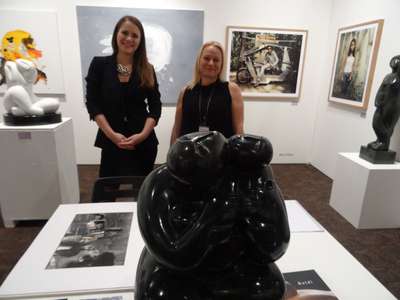Zsófi Faur completed her studies of economics at IBS in 2001. Right after school she opened her art gallery, the Faur Zsófi Gallery.
How did the idea to open an art gallery occur to somebody who studied economics?
I have always lived among art, my father is a collector, my grandmother was a model of the famous Hungarian painter Ödön Márffy. My father and grandfather bought art directly from the artists who are now classics. My family history and connections helped me a lot in setting up a gallery in 2001.
Was this a great time for the art market and what was your focus?
It was rather early, we were among the first private galleries opened in Hungary, at that time we were called Ráday Gallery, in 2010 it is called Faur Zsófi Gallery. We focused on still living but already classical artists who fell into the category of “tolerated” or “forbidden” under socialism. We also worked with contemporary artists however we could not deal with them exclusively. Photo was an option for our gallery. Very soon we began to feel that we need to step out to the world, we could not rely on the local Hungarian market only. Great international professional curators, art dealers do not come to Hungary, so we need to go to where they are. One way to do this is to participate in contemporary art fairs. It was hard to get into this international market at the beginning, it is not easy to get accepted to a fair. Hungarian photographers are well-known worldwide, everybody knows who Robert Capa, Andre Kertész, Brassai were. These iconic names sell Hungarian photography and photography could also fit in the “progressive art” category. We have been participating in international art fairs since 2007 and in this respect we are unique among Hungarian art galleries.
What is it that you received from IBS to help this business?
I liked that IBS trained us for life. This is what generally is missing from Hungarian higher education. We had to do a lot of team works for example. In other universities you are shocked when you step out of the university into real life. You need to be creative, solve problems, you are able to carry out a project from A to Z.
Can you make your living from your gallery?
Before the financial crisis this was a good business, a gallery had to have a unique profile, style, a circle of customers and you could make your living from it. We did not have too many customers but they were regular customers. Since the crisis local customers have practically disappeared. We cannot continue our earlier practice of exhibiting and selling. We need to go abroad which requires finances.
How do you raise the necessary money?
The difficulty of this situation is that we need to be on the safe side I cannot experiment with artists and see how they are doing in the international market. It narrows down our options, we need to sell and from the income to cover the cost of the next fair. I work with those artist whom I am surely can sell. I cannot afford to introduce a new artist no matter that I trust and believe he or she is great. If I cannot sell him or her, I lose money, I cannot afford to risk. You should also know that the financial crisis has the most serious impact on the circle of customers whom we target, who could buy art for 5-15000 Euro. You can always sell very cheap or very expensive works, but the medium level is difficult. People do not believe that what is cheap can be good quality.
Who are your contracted artists?
I work with a few photo-artists. Béla Dóka, Anna Fabricius, Viola Fátyol, Gábor Arion Kudász, Ádám Magyar, Ágnes Éva Molnár, Gergely Szatmári, they are around 35-45 years of age, move internationally, they have a certain acknowledgement already. They are well informed about international trends, some of them have international awards.
Who are your customers?
Mostly Europeans, last year we went to Asia as well. We were in Palm Springs, California in February. Palms Srings is a promising territory for us, where people have the tradition to buy art and they can afford spending money on art. We participated in the SCOPE Miami 2014, in December. To Palm Springs we echibited the works by Béla Dóka és Gegely Szatmári, Ági Podmaniczky Csilla Bondor, and BOLDI.
When did you move your gallery from Ráday street to Bartók Béla?
We moved 5 years ago. The gallery in Ráday street was too small and not really appropriate for exhibitions. This is here a great space for exhibitions, I can set up exhibitions that I like, the shop window, which is the facade of the gallery works really well, not only passengers but everybody can see it even from the by-going trams.
Do you see already the light at the end of the tunnel of the crisis?
It is not easy to answer this. Lack of money is a decisive factor. Photo artists need to go abroad and sell there, they should be informed about international trends and know that East-Central European poverty, difficulties are not selling any more in the West. I am sorry to say but artistic trends and market trends are two things, how a curator approaches art and how a gallerist does that are very different. Artists often should choose between exhibiting or selling. Art has become a product like any other product, and selling is not happening in the galleries but at art fairs. That is, we need to adjust to the new situation if we want to survive and use these transformed marketing channels.
Update, 19 November, 2018
According to Forbes, she is among those 125 persons who make Budapest one of the best place in the wolrd to live. Check it out here.
